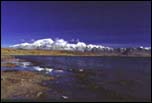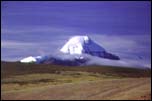Abode of the Gods
... into Tibet
Text and photographs: Nilesh Korgaokar
 Pilgrims returning from Mansarovar, in a symbolic act of purification, discard their old clothes once they are past the Dolma La. The result is a heap of old clothes, footwear, headgear and other items that -- whatever good they may do for the soul -- certainly louse up the fragile environment. Pilgrims returning from Mansarovar, in a symbolic act of purification, discard their old clothes once they are past the Dolma La. The result is a heap of old clothes, footwear, headgear and other items that -- whatever good they may do for the soul -- certainly louse up the fragile environment.
 Past the pile, it is a relief to be actually crossing Dolma La. If you have the will and energy you can make the ritual three rounds of the prayer flags fluttering in the chilly winds and unfurl one of your own. I would recommend a simple prayer rather than adding to the foreign material already flapping there.
The descent on the second night out is comparatively easy. One passes through a valley of flowers and then over many rivulets, many of which may have been formed by the melting snows of Mount Kailas. At one time I was walking down a trail that was flanked by gurgling streams close to which was spread an inviting carpet of flowers. It took all my dexterity to avoid stepping on them.
 After the parikrama we proceeded to the Mansarovar. I expected to see, well -- just a lake. We reached the lake late in
the evening. And since we were in Tibet, the skies were bright enough to afford good visibility.
I was delighted to see flocks and flocks of migrating birds and other
fauna enjoying the serenity of the lake as much as I
was.
 The pristine water of the lake sparkled with shades of rich sapphire and gorgeous green. Walking down to the lake, I startled a rabbit who, to my astonishment, stopped after a few hops and fearlessly took me in. Gathering that he may not have come across many humans, I cooed comfortingly and reduced the distance between us sufficiently to get some close-up pics.
Prancing about in the freezing waters
of the lake were pintails and other wild ducks. I also encountered
a couple of pigeons who had made a home for themselves in an old
abandoned gompa right next to the water.
I hope the Chinese government realises that unbridled tourism can destroy a sanctuary that has survived for so long. More and more people are arriving in
 this territory for a holiday as news of the Chinese government's liberal travel rules spreads. And once vehicles come into this area, dropping beer bottles, aluminium cans, wrappers, clothes and other rubbish on the way, the flora and fauna are going to take a beating. this territory for a holiday as news of the Chinese government's liberal travel rules spreads. And once vehicles come into this area, dropping beer bottles, aluminium cans, wrappers, clothes and other rubbish on the way, the flora and fauna are going to take a beating.
The area perhaps gets time to rejuvenate itself during the cold winter months. But the authorities must consider banning the sale of beer, wine and mineral water. In any case, the natural water of this area is not contaminated. Finicky tourists can sterilise stream water with a few tablets before downing it.
 The authorities can also set set up garbage collection centres in places like Darchen. Or Mansarovar may well go the way of polluted Varanasi. The authorities can also set set up garbage collection centres in places like Darchen. Or Mansarovar may well go the way of polluted Varanasi. In the end, all I can offer is a prayer of hope that
the Abode of the Gods remains as beautiful and bountiful for aeons to come as it was on that memorable day in July.
Fast Facts
How to get there
There are three ways of getting to Mount Kailas from India:
- By air to Kathmandu, Nepal, from New Delhi and from there by road to Darchen or even up to Lake Mansarovar:
Several travel agencies operating out of Kathmandu organise 14-day overland tours to Kailas-Mansarovar. The journey across Nepal to the foothills of Mount Kailas by road takes five days or so. Night halts are organised in tents at camping sites along the way. It is an exhausting drive across difficult terrain.
These agencies charge approximately US $ 2,000 per head. They require at least five working days to organise a Chinese visa. It is relatively easy for Indian passport holders to get a visa these days. The Chinese authorities allow payment for the visa to be made in rupees. The visa costs a maximum of Rs 1,135 per person (the authorities will charge as little as Rs 175 for the visa if they are given one week to process the visa).
Travel agencies that organise these tours are:
- Greenhill Tours, PO Box 5072, Thamel, Kathmandu, tel # 9771-424968, 414803, 416596. Contact person: Santosh Rai or Indra Konzon.
- Tibet Travels and Tours Pvt Ltd, PO Box 72246, Tridevi Marg, Kathmandu, tel # 9771-249140, 250611, 2500748, fax # 9771-249986, 250747. E-mail address: kalden@tibet.wlink.com.np
Tibet Travels and Tours charges US $ 2275 per head. The agency takes groups of five (minimum) between June and October
- By road from India
The Government of India organises tours to Lake Mansarovar in groups of six. The journey is by road from New Delhi to Tawaghat via Gangotri. From there it is a 12 day trek on foot or by yak or pony to Lake Mansarovar. The government advertises these tours every year in early March and April in leading Indian newspapers.
- By air to Kathmandu, Nepal, from New Delhi and from there by air to Yari via Nepalgunj
It is possible now to fly from Kathmandu to Nepalgunj and from there by helicopter to Yari. Yari is on the Nepal side of the Nepal-China border. From Yari, it is about an 8-day trek to Lake Mansarovar.
For details, contact:
- Asian Trekking Pvt Ltd, Tridevi Marg, Thamel, Kathmandu, Nepal, P O Box 3022, tel # 9771-415506, 424249, fax: 411878. E-mail address: expeditions@asian-trekking.com
Geographical details
Mount Kailas, which is part of the Kailas range, is located just north of the main Himalayan range. It is located in the westernmost province of Tibet, Ngari. Mount Kailas is 6714 metres or 22,028 feet high.
Parikrama info
Mt. Kailas is considered a holy mountain. Legend has it that this peak is the centre of the universe, quite literally the bellybutton of the Vishwa.
A pilgrimage that involves circling the mount -- a 52 km lap -- and then a dip in the icy-cold Lake Mansarovar is believed to be one of the most important parikramas a Buddhist or Hindu can achieve in a lifetime. The Buddhist belief is that nirvana-in-a-jiffy can be attained by doing just 108 rounds of the mountain. It is not uncommon to see tough Tibetans doing one "orbit" in a day.
|

